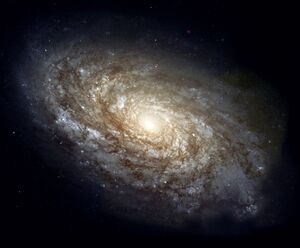
A galaxy
A space void or cosmic void is a large place in space, containing only few or no galaxies and stars. Space voids can be up to 350 millions of light years wide.
Structure[]
Matter in the Universe is condensed into large giant structures known as superclusters, some of them containing over thousands of galaxies and connected one to another through filaments containing galaxies and dark matter. Between them, there is a large empty space, containing only small amounts of matter.
A space void is not quite void. It contains rare galaxies (usually dwarf ones) or at least a few isolated stars. There might be also nebulas, but since there is no star to illuminate them, they are dark and impossible to detect. Also, the space contains tiny amounts of matter, even if it's only about a few atoms per cubic cm.
Stars and planets[]
It is known that space voids have rare galaxies and remote stars. However, nothing is known about the conditions found there. Those galaxies are far less exposed to tidal forces from outside and from merging with other galaxies. They are affected almost only by internal forces. this automatically means that stars can have more circular orbits and nebulas are less disturbed. Cosmic radiations are far less powerful.
As a direct result, galaxies in a void will develop a slightly different network of arms around them. They get birth to new stars much slower then our galaxy and will have enough hydrogen stored in nebulas for a long period of time.
For remote stars, they are unaffected by galactic winds. Interstellar environment is almost free of particles and cosmic rays. There are no galactic tidal forces and no passing stars that could disturb objects in an Oort Cloud or a Kuiper Belt.
As a result, planets orbiting remote stars will not be exposed to cosmic rays and interstellar wind. Outer planets will have smaller deposits of tholins on their surface. Since no external force will divert comets, Kuiper Belts and Oort Clouds will contain many more celestial bodies. Also, inner planets, without bombardment of comets, will have less water on their surface.
The view from one planet will be different. Inside a galaxy, you might find a similar sky to what we see on Earth. There will be many stars and the shape of the galaxy will be visible. A small telescope will not be able to see anything beyond. A civilization born on a planet there, will think, for a long time, that their galaxy is the only one and that is the whole Universe. Only when powerful telescopes will be built, scientists will find out that there are other galaxies at high distance away.
From a planet orbiting a remote star, the sky will look different too. With a naked eye, you will see the sun in day. At night, the only stars one can see will be planets and moons orbiting the same sun. A civilization developed there will think, for a very long period of time, that they are the only thing in the Universe.
A Rogue planet can exist, wandering through the void. If it formed from a very small cloud of dust and gasses, it could contain anything. Temperatures are expected to be very low, below -270 C or 3 K. In such conditions, even helium is frozen. In theory, a small planet made of hydrogen and helium could exist inside a void.
Colonization[]
For a highly advanced civilization that has established colonies throughout the Universe, transport routes will be very important. voids are the best options for transport, since they don't have much matter and there is almost nothing you can impact. Also, given the huge dimensions of the void, it becomes impossible for space pirates to spot a ship and attack it.
The void can be used for many secret projects, including research and deportation. Also, it is a place refugees will search.
Settlers that one day will live on a planet orbiting a remote star inside a void will have a strange feeling, like the whole world has vanished. They will not see any star in the sky except for their sun. Nights will be much darker then what we are used to.
Even more darker will be the view on a Rogue planet. There, the only source of light will be artificial.
Given the huge distances of space, a colony inside a void will be on its own. Gradually it will lose control with its parent state and will develop in its own way.